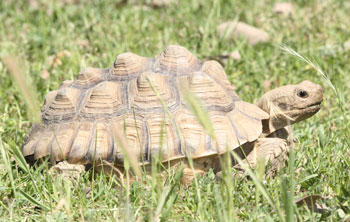
Pyramiding in Tortoises
 Pyramiding, also known as pyramidal growth syndrome (PGS), is a type of abnormal shell growth seen in several species of captive tortoises, including sulcata, leopard, desert and red-footed tortoises. This condition is rare in the wild.
Pyramiding, also known as pyramidal growth syndrome (PGS), is a type of abnormal shell growth seen in several species of captive tortoises, including sulcata, leopard, desert and red-footed tortoises. This condition is rare in the wild.
PGS is characterized by vertical rather than lateral growth of the carapacial scutes. The result of such vertical growth is the conical protrusions seen on the shells of the tortoises in the photos.
The best research article I have read to date on the subject of pyramiding is by A.C. Highfield. I strongly recommend that, if you are keeping a sulcata tortoise, you should read this article. Click on the following link to access the article:
Causes of pyramiding deformity in tortoises
Protein is not a contributing factor to pyramiding; documented studies have been done to substantiate this. Sulcatas get a lot of protein and fat from the seed heads of the native grasses they eat. For example, the grass known in Africa as cram-cram, which is native to the Sahelian area of sub-Saharan Africa, is one such grass. Its botanical name is Cenchrus biflorus and its English common name is Indian goose grass. Quoting from Bernard Devaux's The Crying Tortoise, page 34, "Cram-cram is found everywhere that spurred tortoises live.” The seed of C. biflorus is high in protein and fat and is a big part of the sulcata tortoises' diet in portions of their habitat.
Issues related to pyramiding
Artificial Lighting
Artificial light will never replace natural sunlight. Juveniles in the wild do not spend hours in the sun. They are often in hiding to survive their predators. Adults go in their burrows for weeks and months at a time without exposure to sunlight. Again, there are no established criteria to support some of the stated hours of UVA/UVB needed. Too much artificial light can also contribute to shell deformity. It is more important to get them outdoors a couple of times a week in dappled sunlight than to rely on artificial light.
Humidity

Humidity is very important, but high humidity is not recommended. 45 to 50% humidity is a good range. Read the A.C. Highfield article mentioned above. Burrow humidity is not at 80 or 90%; burrow humidity readings as low as 34% have been recorded. My burrows average 60% humidity.
Soaking
Why? Soaking is sometimes suggested as a method to eliminate pyramiding. While the pyramiding may be reduced, it is an artificial solution to an artificial problem. According to Highfield, soaking exposes the animals to a high risk of fungal and bacterial infections.

Keep fresh water available for tortoises to crawl in if and when they need it. They know better than we do what their needs are! Keep water at the cool end of their enclosure away from the light source. Drinking or soaking in hot water could kill them. Unless they are sick, and for some reason soaking is needed for the healing process, you can cause a lot more harm than good by soaking. Tortoises do take advantage of the rains and ingest large amounts of water. They may not drink again for weeks.
Heat
Evening indoor heat requirement: it is not necessary to keep sulcata tortoises at 60°F (15.5°C) or higher at night. Turn off the heat and lights and let them have a more natural resting period. Most homes do not drop below 50°F (10°C) at night, and this is fine for juveniles. Make sure they have good long-fiber food to eat, and the fermenting process of digesting will help maintain their core temperature at night. The hidebox should not be too large for the size of the animal. Wooden hideboxes insulate from the heat in the daytime and help keep core temperatures even at night.
A daytime temperature of 80 to 85°F (26.6 to 29.4°C) is comfortable for the sulcata tortoises as long as they can retreat to a cooler area to thermoregulate their body temperatures. Remember to provide them with fresh water.

